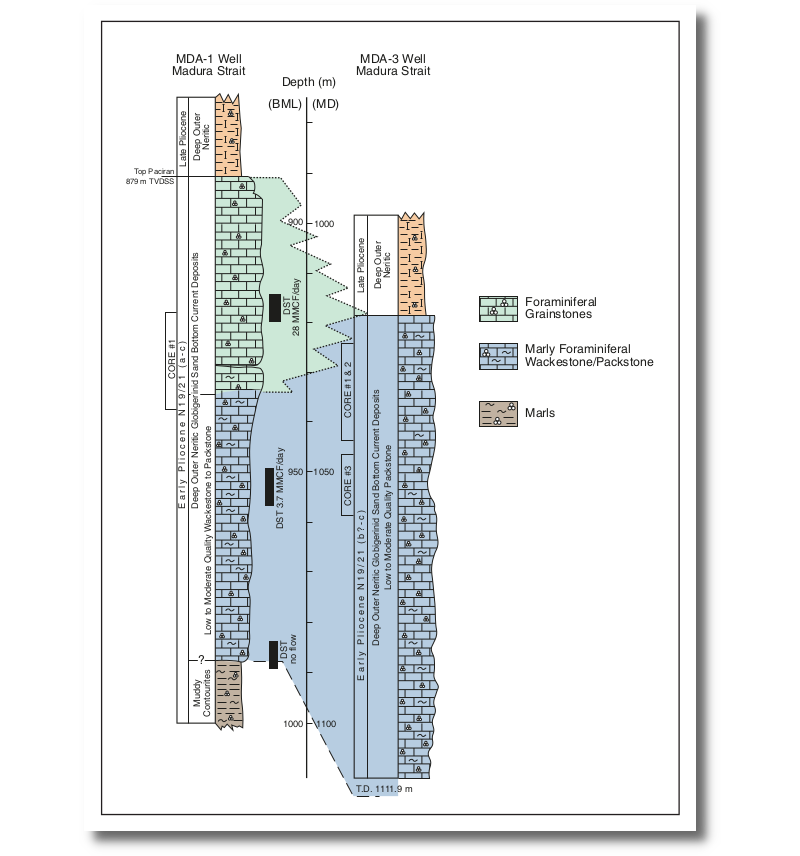Since joining C&C Reservoirs in October 2020, I have been working as part of the Content Team to ensure the success of our first content release of 2021. This release included 42 new and updated Field Evaluation Reports covering 63 reservoirs across the globe, and I am proud to have contributed to this team effort.
The Madura MDA Field, due to the nature of the reservoir interval: contourite drifts demonstrates particular interest to the oil and gas industry. Contouritic drifts are often considered high risk but have attracted the interest of the oil and gas industry over recent years as hydrocarbon exploration has revealed smaller and more subtle accumulations. The Madura MDA Field is an ideal analogue that demonstrates how the Digital Analogue Knowledge System (DAKS) can be used to assist in deciphering the lithological characteristics of contourite drifts that may be present in your reservoir or exploration area.
The Madura MDA
The Madura MDA is an Indonesian field located in the North East Java Sea Basin and was discovered in 1984; it is currently being developed with first gas expected between 2022 and 2023. It is estimated to contain gas initially in place (GIIP) of 200 BCF with an estimated ultimate recovery (EUR) of 150 BCF, representing a gas recovery factor of 75%.
The Lower Pliocene Paciran Member comprises the reservoir interval of the Madura MDA, and is composed of two principal lithofacies (See Figure 1). The upper interval of foraminifera grainstones, termed ‘Globigerinid sands’, is gas-bearing and has good porosity and permeability. It was probably deposited as a foraminifer-rich wackestone/packstone muddy contourite drift, formed through the transportation of suspended clays, micrite and planktonic foraminifers by persistent bottom currents. Subsequent currents have been strong enough to suspend and remove finer clay and micritic sediments, thereby concentrating sand-sized foraminifers into clean, well-sorted foraminifera grainstones. These grainstones have very good reservoir potential with porosities of 37-48% and high permeabilities of 100-1000 mD, resulting from extensive intraparticle pore inter-connectivity through large foraminiferal test apertures. The lower interval, however, has not been winnowed and has a wider range of reservoir quality properties with porosities of 12-42% and much lower permeabilities of 0.1-30 mD.

The contourite drifts observed in the Madura MDA Field show that it is possible for currents to be strong enough to disperse finer-grained material and concentrate coarser-grained sediments, with greater reservoir potential. Today, contourite drifts cover large parts of the Earth’s continental margins and ocean floors, as well as being frequently present throughout the sedimentary record (Rebesco et al., 2014), which emphasises their prospectivity as potential hydrocarbon reservoirs. However, such deposits are still perceived as controversial deep-water deposits due to their similarities to, and difficulties in distinguishing from, gravity- or density-driven turbulent flows, which have previously been the primary focus of interest. Furthermore, interpretational difficulties in lithological characteristics, such as depositional geometries, have thus far hindered their attractiveness to the petroleum industry (Viana et al., 2007).
This is where Field Evaluation Reports (FERs) can assist you. C&C Reservoirs have numerous high-quality and in-depth analogue reports that cover important fields and reservoirs across the world. The FERs within DAKS follow a consistent layout that is developed based upon our pioneering and holistic classification scheme. Through this we can document a clear story through the exploration, development, and production of the selected field, which is of critical importance during the process of comparing analogous field and reservoirs.
Contact C&C Reservoirs today to learn more about how global analogues can be used to make better decisions across the entire E&P lifecycle.
References
Rebesco, M., Hernández-Molina, F.J., Van Rooij, D. and Wåhlin, A., 2014, Contourites and associated sediments controlled by deep-water circulation processes: State-of-the-art and future considerations: Marine Geology, v. 352, p. 111-154.
Schiller, D.M., Seubert, B.W., Musliki, S., and Abdullah, M., 1994, The reservoir potential of Globigerinid sands in Indonesia: Proceedings Indonesian Petroleum Association 23rd Annual Convention, 25p.
Viana, A.R., Almeida, W., Nunes, M.C.V. and Bulhões, E.M., 2007. The economic importance of contourites: Geological Society, London, Special Publications, v. 276, no. 1, p. 1-23.
